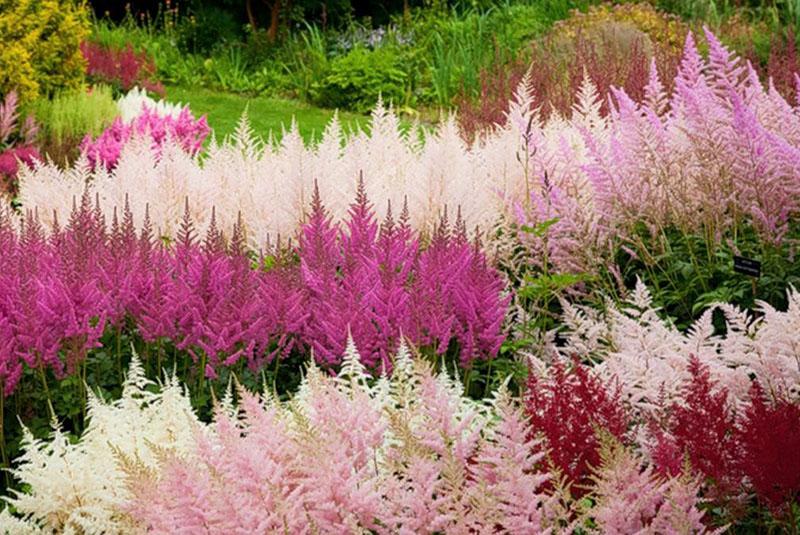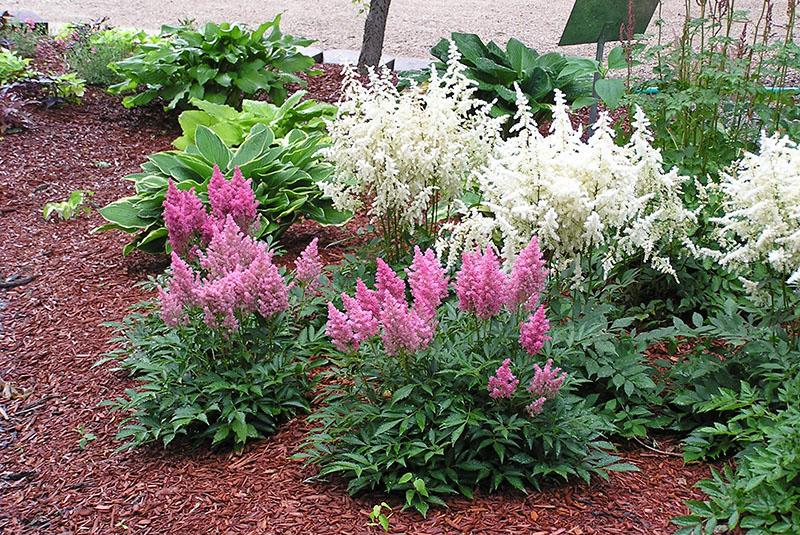Proper planting and caring for astilba outdoors
 Astilba is a perennial flowering plant that is actively cultivated by gardeners on their plots. Planting and caring for astilba in the open field is not very difficult, so the culture is popular. Even a beginner can easily handle this perennial.
Astilba is a perennial flowering plant that is actively cultivated by gardeners on their plots. Planting and caring for astilba in the open field is not very difficult, so the culture is popular. Even a beginner can easily handle this perennial.
Description of the plant

Astilba loves shade and moist soil. In its natural habitat, the plant prefers to grow near water bodies, on the banks of rivers or streams. Sometimes it grows in deciduous forests, in swampy places, where there is high humidity even in summer. It tolerates winter frosts well, subject to high snow cover.
The appearance of the plant depends on the variety of astilba (pictured). Its stems are erect, tough, the height ranges from 15 cm to 2 m. The root system is very powerful, thanks to which the plant is often used by gardeners in the fight against weeds. The leaf plates are double, pinnate, with serrated edges, which are located on rigid petioles, slightly wrinkled.
The main advantage of most types of astilba is that it is decorative throughout the summer season until late autumn.
A good solution for big fans of astilba is to plant varieties with different flowering periods and shades. Flowering begins in early July. Based on the type of plant, inflorescences can be white, burgundy, pink or lilac, presented in the form of a panicle. Their length is up to 60 cm, consists of many small flowers.
The shape of the inflorescences is also varied. The panicles can hang down or vice versa, sharpen up, and also fluff in all directions. The aroma of astilba is also worth noting. The smell is very delicate and unobtrusive. It is especially pronounced in the first half of the day.
Popular types of astilba

The perennial culture has many varieties. In the wild, Astilba is not as attractive as the hybrid varieties that breeders have bred.
All plant species have the following characteristics:
- decorative sheet plates;
- large inflorescences of bright color;
- long and lush flowering;
- resistance to harsh winters.
Perennials are relatively resistant to diseases, as well as to pest attacks, but provided that planting and caring for astilba in the open field is carried out correctly. In addition, all species prefer to grow in shade and in well-moisturized soil.
It is quite difficult to understand the classification of the culture, since more than 350 varieties of astilba are already known and this figure is not final. The varieties were classified according to the shape of the inflorescences, the size of the bush, and the origin.
Not everyone knows that, in addition to decorative properties, astilba also has medicinal properties. It is believed to help with fever and various inflammations.In Japan and China, this plant is used to prepare a seasoning that is used in cooking meat.
The shape of the inflorescences is distinguished:
- paniculate - inflorescences with many branches that adjoin the main axis at an acute angle;

- pyramidal - inflorescences of lateral branches adjoin the main axis at right angles;

- drooping - inflorescences with flexible branches facing the ground;

- rhombic - inflorescences resemble a rhombus in shape.

According to the height of the bush, there are several types: dwarf (below 30 cm), undersized, medium-sized and tall astilbe.
By hybridization (origin), perennials are divided into the following species:
- astilbe hybrids naked;
- simple-leaved hybrids;
- pink hybrids;
- Japanese hybrids;
- hybrid astilbe;
- Chinese Astilba hybrids;
- astilboides hybrids.
Some of these groups are very numerous, some of them have no more than two varieties, for example, pink hybrids.
Planting and caring for astilba in the open field
 The development, growth of the plant, abundant long flowering depends on many important factors: location, planting material, planting time and full subsequent care.
The development, growth of the plant, abundant long flowering depends on many important factors: location, planting material, planting time and full subsequent care.
Competent agricultural technology consists in the following activities:
- watering and timely fertilization;
- regular pruning;
- preventive spraying and inspection of the crop for pests and diseases;
- preparation for the winter period.
It is also necessary to periodically loosen the soil and mulching.
Landing rules
 Planting astilba in open ground and the subsequent care of the crop should be started with the preparation of planting material, soil and the choice of a growing place.
Planting astilba in open ground and the subsequent care of the crop should be started with the preparation of planting material, soil and the choice of a growing place.
The correct development of culture largely depends on the chosen place. Astilba loves shade, but warmth is also important to her. Therefore, experienced gardeners recommend choosing partial shade. Do not plant crops in open areas with direct sunlight. The inflorescences will gradually become small, and the flowering will not be so long and plentiful. At the same time, it is noted that the shade of the panicle is much paler. There are varieties that prefer sunlight, but these are few.
 As for the soil, any fertile soil is suitable for this perennial, it is good if groundwater is located nearby. You should not plant a bush next to those trees whose root system is close to the surface. In this case, crops will constantly struggle for moisture, and the superiority will be on the side of the tree. It will ruin Astilba.
As for the soil, any fertile soil is suitable for this perennial, it is good if groundwater is located nearby. You should not plant a bush next to those trees whose root system is close to the surface. In this case, crops will constantly struggle for moisture, and the superiority will be on the side of the tree. It will ruin Astilba.
Before planting, the soil must be dug up, peat or humus must be added, as well as a complex mineral fertilizer. Dig a hole 30 cm deep. In this case, you should plan the site in advance if there are several bushes. The distance between undersized and dwarf varieties should be at least 30 cm, between large and medium - from 50 cm.
 After planting astilba in open ground, you need to water the seedling abundantly and form a layer of mulch from 3 cm on top. This will protect the still undeveloped root system from drying out.
After planting astilba in open ground, you need to water the seedling abundantly and form a layer of mulch from 3 cm on top. This will protect the still undeveloped root system from drying out.
It is recommended to prepare planting material in advance. To do this, you need to soak the roots of the plant in special preparations - Zircon, Epin-Extra. These funds stimulate growth well.
Crop care after planting
 In the spring, after the snow melts, the bush rises slightly above the soil level. Therefore, first of all, the root zone should be sprinkled with soil enriched with minerals to the point of growth. Further, in order to prevent the roots from drying out, the soil should be mulched.
In the spring, after the snow melts, the bush rises slightly above the soil level. Therefore, first of all, the root zone should be sprinkled with soil enriched with minerals to the point of growth. Further, in order to prevent the roots from drying out, the soil should be mulched.
 Astilba loves moisture, but it is necessary to water the soil abundantly not only for this reason. The root system of the plant is arranged in such a way that its lower processes gradually die off, and the upper ones, on the contrary, actively grow. It is at these moments that the culture especially needs full watering.Astilba is watered twice a day during the formation of inflorescences, but it is important to ensure that the water is warm or at room temperature.
Astilba loves moisture, but it is necessary to water the soil abundantly not only for this reason. The root system of the plant is arranged in such a way that its lower processes gradually die off, and the upper ones, on the contrary, actively grow. It is at these moments that the culture especially needs full watering.Astilba is watered twice a day during the formation of inflorescences, but it is important to ensure that the water is warm or at room temperature.
Abundant and long-term flowering requires a lot of energy, so perennials require timely feeding. Astilba has a positive effect on all types of fertilizers, but most experts believe that it is better to feed the plant with a compost-peat mixture and rotted manure. Gardeners noticed that if you properly organize the feeding regime, then the culture will not need a transplant for 10-15 years.
 For better access of oxygen to the roots, it is necessary to periodically loosen the soil near the root zone, and at the same time remove weeds. It is also necessary to protect the plant's root system from frost. In the fall, before the onset of cold weather, astilba needs to be covered with spruce branches or special covering material. Perennial is quite resistant to frost, however, spring frosts pose a danger to it when the snow has already melted.
For better access of oxygen to the roots, it is necessary to periodically loosen the soil near the root zone, and at the same time remove weeds. It is also necessary to protect the plant's root system from frost. In the fall, before the onset of cold weather, astilba needs to be covered with spruce branches or special covering material. Perennial is quite resistant to frost, however, spring frosts pose a danger to it when the snow has already melted.
Particular attention should be paid to pruning the plant. It must be carried out in a timely manner and fulfill a specific purpose. In different periods, astilbe will require rejuvenating, shaping, sanitary and thinning pruning.
The main purposes of pruning include:
- regulation of the process of growth and development;
- formation of the desired shape;
- lush and long flowering;
- prevention and treatment of diseases;
- removal of old, dry, weak processes.
The mistakes that beginners make during pruning often lead to the opposite results - astilba blooms poorly, tolerates frosts hard, gives shoots that significantly thicken the shrub.
Reproduction of astilba

Astilba can be propagated in the following ways:
- seeds;
- dividing the bush;
- by cuttings.
 To preserve the varietal qualities of the crop, you should not try to grow astilba from seeds. The obtained specimens do not correspond to the color characteristic of the variety, have a low decorative effect, and have a short flowering period.
To preserve the varietal qualities of the crop, you should not try to grow astilba from seeds. The obtained specimens do not correspond to the color characteristic of the variety, have a low decorative effect, and have a short flowering period.  The method of dividing the bush or grafting is much more effective. In addition, these two methods are much easier and more affordable.
The method of dividing the bush or grafting is much more effective. In addition, these two methods are much easier and more affordable.
In landscape design, it is customary to combine astilbe with different types of coniferous crops, especially since they perfectly protect it from direct sunlight. From flowering crops, perennial looks organically with tulips, irises, as well as periwinkle and hosta.
Diseases and pests
 Astilba is very resistant to various diseases and attacks of insect pests, but only with proper care and preventive measures. The culture can be threatened by the slobbering penny, which significantly slows down the development and flowering of the plant. In some cases, the root system of the bush is attacked by the root knot nematode. It gradually eats up the roots, and the plant withers.
Astilba is very resistant to various diseases and attacks of insect pests, but only with proper care and preventive measures. The culture can be threatened by the slobbering penny, which significantly slows down the development and flowering of the plant. In some cases, the root system of the bush is attacked by the root knot nematode. It gradually eats up the roots, and the plant withers.
Of the diseases, Astilba can suffer from bacterial spotting, which is treated with special preparations containing copper, as well as from viral infections. In case of significant infections with viruses, infected specimens must be destroyed.
Astilba is a very beautiful perennial, which attracts gardeners not only for its decorative qualities, but also for simple rules of agricultural technology, unpretentiousness, resistance to diseases, pests and severe frosts. It is known that the crop is able to resist weeds on the site. There are many varieties and varieties of perennials. Each gardener can choose the preferred shade and height of the shrub for their garden.